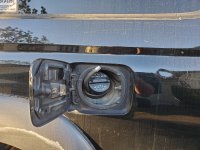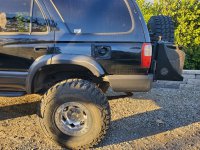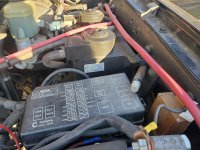Do you know of anyone not having luck with 9" diffs and bellows?
I wonder if a loose mesh will create more airation? Maybe less heat, at first, but fills with air and that's what causes the bubbling out the breather??
The 9" creates more internal pressure due to the lower pinion and high tooth engagement. You'll also find the high pinions tend to create more internal pressure.
Racing and mild trail wheeling are two completely different ends of the spectrum, with everything else falling in between.
Look under desert race trucks to see how big their vents are. Many of them are even running dual vents.
On any axle, the trick is to allow the axle to breathe, it needs to easily vent pressure out, but it also needs to suck air in.
Think of a hot axle dropping into a cold water crossing or mud hole..... That axle is going to cool off rapidly, causing it to contract. It's going to want to suck air in to equalize. If your vent isn't big enough or it's clogged, it will pull in past your seals (axle and/or pinion). If your axle is under water, guess what it is sucking in? Yep, water.
This is why you hear reports of people claiming everything is new, everything is sealed up perfectly, but they still get water in their axles. Especially common in people who run in the mud all the time.
Proper venting is an absolute necessity when running Air Lockers. When you see someone spitting oil out of their solenoids, it's often because their axle housing is over pressurizing and instead of venting out the vent, it is venting out past the seals in the Air Locker.
The keys to proper axle venting:
- Run a decent sized vent, go 5/16" minimum all the way through, no neck downs.
- If you are going fast, go bigger, 3/8" minimum, 1/2" or dual 3/8" would be better.
- If you're running a 9/10" go 3/8" minimum.
- Relocate vents from the axle tubes to the diff center, that's where the majority of the pressure is created, vent it there.
- Install a small splash shield over your vent hole on the inside of the axle to keep oil from being splashed into the vent tube. Look inside a Toyota axle for an example.
- This is not an optional thing. The inside of a diff housing is a oily, misty slurry being flung all around. Keep it from getting into your vent tube.
- Run a long vent tube. Run it up straight up to the chassis (with room for droop) and then up as high as you can, even into the body, then loop it down back to itself to create an air trap and stick a small filter in the end of it. I like those little see-through plastic gas filters you put on garden equipment, but you could use those fancy vent cans like YJLOPES showed earlier.
- You want it as vertical as possible, especially coming out of the housing, so any oil that gets into it, will drain back easily.



